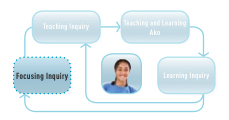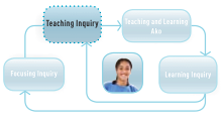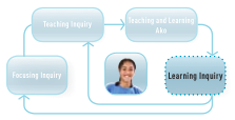Moira teaches a year 3 class in a large, multicultural, decile 5 school. She is the school’s teacher in charge of mathematics. She focused her inquiry on eight students, most of whom were Māori or Pasifika; the others were Middle Eastern, Indian, and Pākehā. Many were English-language learners.
Moira’s inquiry question was:
Will introducing problem-based tasks improve the mathematics achievement of lower-performing students?
Moira’s focusing inquiry
What was important, given where Moira’s students were at?
Moira was clear about the dual purpose of her inquiry: “to improve the achievement of the students and for myself, the teacher, to improve as an inquirer into my practice”. She used her mathematics achievement data to identify her target students for the inquiry, focusing on those whose achievement was below expectation for their age.
When Moira examined the data and observed the students’ independent work in mathematics, she identified a number of issues, the most significant being “the apparent inability of the low-achieving group of children to work effectively on mathematical tasks independently of the teacher”. The students enjoyed the three practice sessions that were part of their weekly mathematics rotation, but much of their talk and behaviour was off task. The same students were able to work co-operatively and independently on tasks in reading, and Moira wondered why this was so.
Moira decided that she would use both qualitative and quantitative methods to track her own progress and that of her students throughout her inquiry. For example, she chose to use two assessment tools from the Numeracy Development Projects to monitor shifts in the students’ knowledge and strategies for solving number problems. She recorded these shifts on a tracking sheet at three points during her inquiry.
Moira’s qualitative data included student interviews along with formal observations conducted with the help of a colleague. She used the observations to monitor the students’ conversations and behaviour during independent activities, noting the proportion of time spent in talk and activity that was on or off task. Her hope was that increased engagement in mathematical tasks and discourse would lead to higher levels of achievement.
What research evidence did Moira draw on?
Moira used the Numeracy Project Assessment (NumPA) tool and the Global Strategy Stage (GloSS) assessment to understand national norms for achievement in mathematics in year 3 and to find out about her students’ knowledge and mental strategies. Both these tools are available on the nzmaths website, which provides a great deal of material from the Numeracy Development Projects. This material includes information about the Number Framework, which helps teachers, students, and parents to understand the typical progress and stages in the Number and Algebra strand of mathematics and statistics.
Moira referred to the Assessment Resource Banks to explore the phrase “mathematical discourse”, which she was using to describe the kind of talk she wanted her students to engage in during their mathematics lessons.
Mathematical classroom discourse is about whole-class discussions in which students talk about mathematics in such a way that they reveal their understanding of concepts. Students also learn to engage in mathematical reasoning and debate.
Discourse involves asking strategic questions that elicit from students both how a problem was solved and why a particular method was chosen. Students learn to critique their own and others' ideas and seek out efficient mathematical solutions.
New Zealand Council for Educational Research, page 1
What evidence did Moira use from her own practice or that of her colleagues?
Table 1 is an excerpt from Moira’s tracking document. It shows that at the start of the intervention, all the students were achieving below expectation for students in their year group.
Moira summarised an early observation as follows:
After 5 minutes, Student 1 was still looking for her book, Student 2 was looking in her tray for a pencil, and Student 3 had only written his name. The remaining four had split into two groups of two and were engaged in the task – some practice number one to ten cards with a recording sheet.
After 10 minutes, Student 3 had moved over to sit with one of the pairs; however, he had almost all incorrect, while the other two had them correct, so he still wasn’t working with them. Student 2 had tried to sit with the two girls, who had moved again to another table; they were going well with all correct and were discussing the work. Student 1 had finally found her book and had headed up the date.
After 15 minutes, both the pairs had completed their work, glued it in their books, and were playing with multi-link cubes. Student 1 was [off task] sharpening her pencil, less than halfway through [the task]; Student 2 had almost finished, and they were correct; and Student 3 was now playing with a glue stick, having ignored the almost completed sheet for the last few minutes.
Moira’s interviews with the target students helped her to discover their perspectives on mathematics. She recorded her findings in her journal:
Early interviews showed that the group had a positive attitude towards maths and their own ability. They enjoyed doing sums or worksheet-type activities, though they liked to be able to do these in pairs or in groups. These types of activities didn’t promote a lot of mathematical discourse.
Table 1: Excerpt 1 from tracking document | Number Framework stages
| Students’ status at start of term 1
|
|---|
| 4: Advanced Counting
| Expectation
|
| 3: Counting from One by Imaging
|
Cause for concern
MJ
|
| 2: Counting from One by Materials
|
At risk
R, F, C, H, J, A
|
| 1: One-to-One Counting
| At risk
|
| 0: Emergent
| At risk
|
Moira’s teaching inquiry
What strategies were most likely to help Moira’s students learn what they needed to learn?
Moira knew that the Numeracy Development Projects advocate the use of problem-based tasks that focus on students’ sense-making activities. She already used this kind of task with students who were achieving at or above expectation and had found that they were effective in stimulating their mathematical thinking and discourse. However, she had been giving her lower-achieving students tasks that involved lower-level thinking, including memorising or repeating learned facts. Moira thought that these tasks provided more support for these students, especially for those who were English-language learners and who sometimes “get lost in the wording and can’t find the maths”. She wondered whether a shift to problem-based tasks would engage these students more and lead to their achieving at a higher level:
'I modified the tasks that the children were doing during the practice part of their weekly rotation to problem-based tasks. I wanted these to relate to real experiences for the children to highlight the links between maths and real life … These were done in pairs or small groups, depending on the nature of the task. Teaching time was spent going over how to work effectively on problem-based tasks. This was also an opportunity to follow up on the level of thinking that had occurred during the activities completed without the teacher.
I also spent more time pre-teaching the mathematical language. I put lots of vocabulary up around the classroom and wrote the problems out in words. This meant that the students had lots of models of the language being used in different contexts.'
The teaching focus during the intervention was on the operational domains of addition/subtraction and multiplication/ division. An example of the tasks Moira set was:
How many ways can you share $12, $16, or $18 between two people? How many ways can you share $12, $15, or $18 between three people?
What research evidence did Moira draw on?
One of Moira’s key sources was the recently published Effective Pedagogy in Mathematics/Pāngarau: Best Evidence Synthesis Iteration (Anthony and Walshaw, 2007). The authors report that “In the mathematics classroom, it is through tasks, more than any other way, that opportunities to learn are made available to students” (page 94).
The synthesis notes that evaluation reports and papers from the Numeracy Development Projects “suggest that tasks that requirestudents to justify their solution strategies and reflect on their thinking support student gains in computational proficiency” (page 95). The synthesis emphasises the creation of mathematical communities of practice in which language plays a central role:
The teacher who makes a difference for diverse learners is focused on shaping the development of novice mathematicians who speakthe precise and generalisable language of mathematics.
page 69
What evidence did Moira use from her own practice or that of her colleagues?
As discussed above, Moira noticed that, prior to the intervention, she had tended to set tasks for her higher-achieving students that gave them opportunities to use and apply their mathematical knowledge. In contrast, she would give her lower-achieving students tasks intended to improve their understanding and recall of basic facts, for example, using cards and dice to practise addition, subtraction, multiplication, and division.
Moira’s learning inquiry
What happened as a result of Moira’s teaching, and what are the implications for her future teaching?
Moira used the observation records to tally up the amount of time the students spent engaged in organising or carrying out each mathematical task. Her data showed that by the end of her intervention, the target students were spending a far higher proportion of their time engaging in mathematical discourse and were showing much more enthusiasm and motivation for their shared tasks in mathematics.
'The introduction of the problem-based tasks meant that they spent more time talking about the problems and ways of solving them, not just checking answers.'
From the NumPA assessments, it was clear that the students’ rate of improvement was significantly greater than that achieved by similar students in past years.
'The results show a positive trend, which we can say is likely to have been influenced by the intervention. All the students who have comparative data have made noteworthy gains in the operational domain of using strategies to solve addition, subtraction, and place value problems. These were considerably more than the expected movement.'
Moira’s inquiry had consequences for her own learning and pedagogy that went beyond this particular group of students. Moira had always used problem-solving tasks as a means of extending higher-achieving students. She now realised that such tasks are excellent for engaging students at all levels and ensuring a higher level of mathematical thought and discussion:
In professional discussion with associates and the course lecturer, I have had the chance to examine my own pedagogy and think about why I believe what I do about different strategies and how they might work with different groups of students.
At an even deeper level, Moira reflected on the ways in which she interacted with her Māori and Pasifika students and the impact this had on their learning. Her reading and the conversations she had with her colleagues and lecturer reinforced her understanding that her target students’ underachievement had not been due to an innate lack of ability. The students were able to achieve when she made changes in her teaching strategies. Interestingly, Moira reflected that her English-language learners didn’t seem to regard language as being as much of a barrier as she did. As a consequence of these reflections, Moira made the difficult admission to herself that “deficit thinking” had influenced some of her teaching decisions:
Systems and routines that I had thought were culturally aware and inclusive in recognising and celebrating the range of cultures within the class may be responsible for reinforcing stereotypes; there is more that can be done to truly embrace and value diversity.
What research evidence did Moira draw on?
Moira learned more about the concept of deficit thinking by reading texts by researchers in the Te Kōtahitanga project. In describing how different groups explain the main influences on Māori students’ educational achievement, Bishop et al. explain that deficit thinking:
means that the speakers tended to blame someone or something else outside of their area of influence and as a result they suggest that they can have very little responsibility for the outcomes of these influences. The main consequence of such deficit theorising for the quality of teachers’ relationships with Māori students and for classroom interactions is that teachers tend to have low expectations of Māori students’ ability or a fatalistic attitude in the face of systemic imponderables. This in turn creates a downward spiralling self-fulfilling prophecy of Māori student [under] achievement and failure.
2006, page 10
What evidence did Moira use from her own practice or that of her colleagues?
The tracking document enabled Moira to check the progress of her target students. Table 2 shows that, by the end of the intervention, five of the students were at the expected level for students in their year group, and three were still of concern. None of them were now “at risk”. Table 3 is an excerpt from one of the observation records Moira used to monitor her students’ engagement in their learning. It shows that most of the students have moved quickly into organising the task and engaging in mathematical talk and activity. When Moira analysed this session, she found that the students had used the mathematical thinking skills of collaborative problem-solving, describing a solution method, structuring and organising information in a recording table, and assisting others to clarify a solution method.
Table 2: Excerpt 2 from tracking document | Number Framework stages
| Students’ status at start of term 1
| Students’ status at end of term 2
| Students’ status at end of term 3
|
|---|
| 4: Advanced Counting
| Expectation
| Expectation
|
Expectation
MJ, R, C, H, A
|
| 3: Counting from One by Imaging
|
Cause for concern
MJ
|
Cause for concern
MJ, R, F, C, H, J, A, M
|
Cause for concern
F, J, M
|
| 2: Counting from One by Materials
| At risk R, F, C, H, J, A
| At risk
| At risk
|
Table 3: An excerpt from an observational record during independent group time | Date: 25 July 2007
|
Group members: A, F, J, C, N, H, M
(A, C, J together; F, N, M, H together)
| Task: Count how many sticks are in a pile by bundling them into groups of ten.
|
|
|
|
|
|
|
| Time
| Task organisation related talk and/ or activity
|
Mathematical talk and/or activity
|
Other talk and/
or activity
| Examples
|
|---|
| 9:34 a.m.
| 5
| 1
| 1
|
C starts bundling sticks
Others start organising sticks/whiteboards/group
roles
|
| 9.36 a.m.
| 1
| 4
| 2
|
H draws up recording table
M, C, F, J bundle sticks into groups of ten
|
| 9.38 a.m.
| 0
| 5
| 2
|
C and A wait and watch counters
J and F count to make groups of ten
H and N discuss counting bundles
M bundles while listening to H and L
|
What happened next?
Following the intervention, the students in Moira’s target group continued to improve; by the end of the year, they were all achieving at expectation in their mathematics learning. They seemed to be more motivated and to have developed a new set of learning skills that they were able to apply to different curriculum areas.
The learning has continued for Moira too:
'It challenged my beliefs about the children’s ability to problem solve and their use of language. I had to be open to challenging why and how I did things. It’s been a permanent shift – I see myself as a continuous active learner and inquirer. I’m more deliberately focused on trialling things for the children. This year, I’ve been looking at inquiry using interactive whiteboard technology. I’ve deliberately focused on a small area and using that for improvement.
I think the big message is that what changed wasn’t that radical. It was the process of analysis that made it so successful. It was a great process – it motivates you to keep doing that inquiry with small groups in the class.'
Reflective questions
What questions does this story raise for you and your colleagues about:
- the tasks you provide for your lower-achieving students?
- your expectations for your students?
- your use of problem-solving tasks?
- your monitoring of student learning?
- the importance of mathematical discourse?
- the possible influence of deficit thinking on your teaching practice?
References
Anthony, G. and Walshaw, M. (2007). Effective Pedagogy in Mathematics/Pāngarau: Best Evidence Synthesis Iteration [BES]. Wellington: Ministry of Education.
Bishop, R., Berryman, M., Cavanagh, T., Teddy, L., Clapham, S., and Walker, R. (2006). Whanaungatanga: Addressing the Problem of Improving Māori Student Achievement. Paper presented as a symposium at the New Zealand Association for Research in Education National Conference, Manaakitanga: Feel the Spirit, 6 December, Rotorua.
Global Strategy Stage (GloSS) assessment
New Zealand Council for Educational Research. Mathematical Classroom Discourse. In Assessment Resource Banks.
nzmaths
Numeracy Project Assessment (NumPA)
Published on: 26 Aug 2009
Return to top





